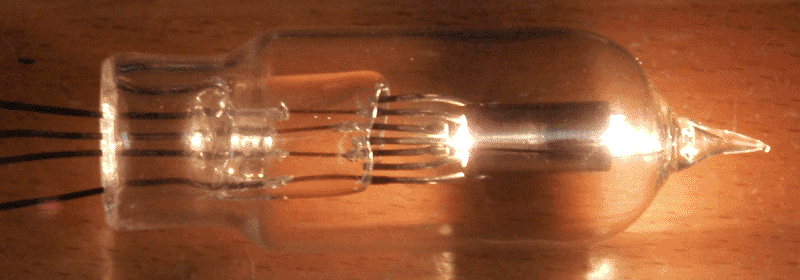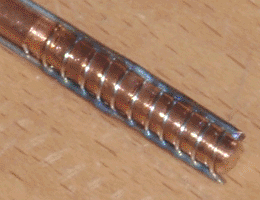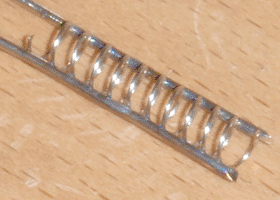
Before building another power triode, I decided to fix some of the durability issues in previous tubes. I made a new triode, in which I reinforced the plate and grid to make them less likely to be knocked out of position during handling of the tube. Since this tube was designed to be durable, I also made it small and low-powered, so that it would be suitable for use in a portable radio or another similar device. It uses the smallest envelope size, and the filament is 1.75 inches of 0.04mm tungsten wire bent into a long inverted "U" shape. This results in a maximum filament setting of 500mA at 12 volts, suitable for use with a sealed lead-acid battery.
Construction of the tube components was typical with the exception of the grid, which can be seen below. I built it by winding 0.32mm nickel wire around a threaded copper mandrel, then spot-welding two 0.8mm nickel supports to the coil while it was still wrapped around the copper. Due to its high conductivity, the copper is essentially "invisible" to the spot welder; this enables it to be used in welding jigs for small, complex parts. This method appears to be highly useful, and I will utilize it in future tube builds.


In testing this tube, I took a slightly different approach than usual. I've seen various sources mention that bright emitter (pure tungsten filament) tubes perform best at high voltages, so I decided to find this triode's absolute maximum characteristics. I set the filament to 12 volts and brought the plate voltage slowly up, with the grid tied to +12V. At approximately 500V the plate was glowing a dull red and was conducting roughly 40mA, dissipating 20 watts of power. Since in my tubes the plate is also the getter, this high-temperature operation is actually beneficial, and further improved the level of vacuum. I ran the tube at this power level for approximately 5 mintues, then turned off the plate supply and decreased the filament voltage to 6 volts. Due to the excellent thermal characteristics of Pyrex, there was no apparent damage to the glass from this thermal cycling.
I had initially planned to record the characteristics of this tube in graph format, but in testing the extremes of this tube I have found that the characteristics of bright emitter tubes are heavily dependent on the filament power, which itself has a very wide range. In the case of this tube, there is detectable emission with as low as 6 volts on the filament, which increases by multiple orders of magnitude as this is increased to 12 volts. The characteristics of each tube are therefore almost entirely application-specific. For future tubes I will most likely record only the absolute maximum characteristics, at the point where the plate becomes incandescent. I may also attempt to find some way to express the grid's influence as a percentage of the total emission, since the transconductance also varies with filament power.
While this tube was a success in a number of ways, I don't think I will use it in a portable device. The filament current of 350-500mA, while lower than that of previous tubes, would still present a significant load to a small rechargeable battery. The available output power is also far in excess of what is necessary to drive a pair of headphones. I will most likely build a very similar tube using a 0.025mm filament, so that the current will be in the range of 150-250mA. Before doing so, however, I will give this tube a base and a socket.